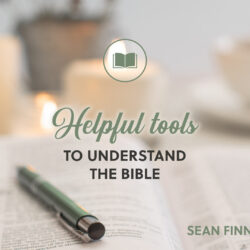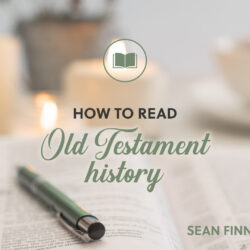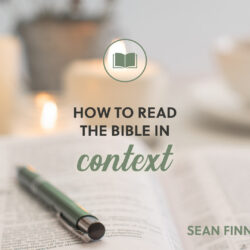This is part 2 of the Read the Bible For Yourself.
As I endeavored to show last time, the Bible is one of a kind. It’s the result of dozens of authors, working under God’s inspiration to produce scrolls of text over centuries. This process resulted in sixty-six books, including histories, legal texts, poetry, prophetic oracles and much more. Today we’ll spend some time just getting oriented. We’ll cover which books are in the Bible, the various genres, how references work, and ways that you can access the Bible.
Listen to this episode on Spotify or Apple Podcasts
—— Links ——
- See other episodes in Read the Bible For Yourself
- Other classes are available here, including How We Got the Bible, which explores the manuscript transmission and translation of the Bibe
- Get the transcript of this episode
- Support Restitutio by donating here
- Join our Restitutio Facebook Group and follow Sean Finnegan on Twitter @RestitutioSF
- Leave a voice message via SpeakPipe with questions or comments and we may play them out on the air
- Intro music: Good Vibes by MBB Attribution-ShareAlike 3.0 Unported (CC BY-SA 3.0) Free Download / Stream: Music promoted by Audio Library.
- Who is Sean Finnegan? Read his bio here
—— Notes ——
The Bible is not a single book, but a collection or library of sixty-six books.
- Genesis
- Exodus
- Leviticus
- Numbers
- Deuteronomy
- Joshua
- Judges
- Ruth
- 1 Samuel
- 2 Samuel
- 1 Kings
- 2 Kings
- 1 Chronicles
- 2 Chronicles
- Ezra
- Nehemiah
- Esther
- Job
- Psalms
- Proverbs
- Ecclesiastes
- Song of Solomon
- Isaiah
- Jeremiah
- Lamentations
- Ezekiel
- Daniel
- Hosea
- Joel
- Amos
- Obadiah
- Jonah
- Micah
- Nahum
- Habakkuk
- Zephaniah
- Haggai
- Zechariah
- Malachi
- Matthew
- Mark
- Luke
- John
- Acts
- Romans
- 1 Corinthians
- 2 Corinthians
- Galatians
- Ephesians
- Philippians
- Colossians
- 1 Thessalonians
- 2 Thessalonians
- 1 Timothy
- 2 Timothy
- Titus
- Philemon
- Hebrews
- James
- 1 Peter
- 2 Peter
- 1 John
- 2 John
- 3 John
- Jude
- Revelation
The Old Testament includes 39 books, written in Hebrew and Aramaic.
- History [Torah, Judges, Kings, Exilic]
- Poetry [Philosophy, Songs, General Wisdom, Subversive Wisdom, Romance]
- Prophecy [Pre-Exilic, Exilic, Post-Exilic]
The New Testament includes 27 books, written in Greek.
- History [Jesus, Church]
- Epistles [To Churches, Pastoral, General]
- Prophecy [Apocalyptic]
Genres
- historical narrative: Genesis, Exodus (first half), Numbers, Joshua, Judges, Ruth, 1-2 Samuel, 1-2 Kings, 1-2 Chronicles, Ezra, Nehemiah, Esther, Jonah, Matthew, Mark, Luke, John, Acts
- biography: Ruth, Ezra (partial), Nehemiah (partial), Esther, Jonah, Matthew, Mark, Luke, John, Acts (partial)
- law: Exodus (second half), Leviticus, Deuteronomy
- poetry: Job, Psalms, Proverbs, Ecclesiastes, Song of Solomon, Lamentations
- prophecy: Isaiah, Jeremiah, Ezekiel, Daniel, Hosea, Joel, Amos, Obadiah, Micah, Nahum, Habakkuk, Zephaniah, Haggai, Zechariah, Revelation
- wisdom: Job, Psalms (partial), Proverbs, Ecclesiastes
- epistles: Romans, 1-2 Corinthians, Galatians, Ephesians, Philippians, Colossians, 1-2 Thessalonians, 1-2 Timothy, Titus, Philemon, Hebrews, James, 1-2 Peter, 1-3 John, Jude, Revelation (partial)
- apocalyptic: Daniel (partial), Zechariah (partial), Revelation
Subgenres
- parables (2 Samuel 12.1-7)
- riddles (Judges 14.14)
- aphorisms (Proverbs 15.1)
- monologues (Job 3.3-26); Matthew 5-7)
- dialogues (Genesis 4.9-15)
Additions to the Text
- chapters
- verses
- paragraph headings
- book introductions
- cross-references
- textual notes
- translation notes
- study notes
- italicized words
- capitalized words
- red words
How References Work
- 1 Kings 3.4 = First book of Kings, chapter 3, verse 4
- separator between chapter and verse can be a colon, a period, or even a superscript font
- 1 Kings 3.1-4 = verses 1 through 4 of chapter 3 of 1 Kings
- 1 Kings 3-4 = chapters 3 through 4 of 1 Kings
- we use a semicolon to separate between chapters and a comma between verses (1 Kings 3.4, 7, 15; 16.1-20; 18)
- we use an “a” or “b” to mark the first half or second half of a verse (1 Kings 3.4b)
- we use an “f” to include the verse following the starting verse (1 Kings 3.4f = 1 Kings 3.4-5)
- we use an “ff” to include all the verses to the end of the chapter (1 Kings 3.4ff = 1 Kings 3.4-28)
- we often abbreviate book names to their first syllable.
Ways to Read the Bible
- paper bible: any “standard” version
(NRSV, ESV, NASB, CSB, etc.) - website: biblegateway.com, biblehub.com
- app on your phone: YouVersion, Bible.is
- app on your computer: Logos, Accordance
Review:
- The Bible is not a book, but a library of 66 books.
- The Bible breaks into two main divisions: Old Testament (39 books) and New Testament (27 books).
- The Bible contains different genres that affect how we read, including historical narrative, biography, law, poetry, prophecy, wisdom, epistles, and apocalyptic.
- Even within genres, we can find subgenres like parables, riddles, aphorisms, monologues, and dialogues.
- Although God inspired the text of scripture, other additions of publishers are subjective and devoid of divine authority.
- Reference styles vary but follow the format of book => chapter => verse.
- The Bible is available as a bound book, on websites, on phone apps, and on computer apps.







Sorry if I wasn’t very clear in the last comment. I wasn’t able to see my text well since it’s black on dark grey/black for some reason and left it short.
I agree with your response. My point was just we all have a background and pictures in our minds already when it comes to certain terms/beliefs/words/phrases/doctrines before we ever come to the Bible. I was brought up on Left Behind series books/movies… so I already had this background of “We are in the end times” before I grew up and it caused a lot of issues. Especially when I first studied more, rejected that end times view and embraced another one, and then years later rejected the 2nd view since I don’t think we are in the “end times” now. It really screwed with me. I’ve basically had to crawl my way back into it studying since it scared me off so much in my understanding. That’s way more than a comment can handle haha.
The double-edged sword is that we are continuing to learn and we need others to help us gain a different perspective-yet it can lead us astray too, or help us gain more understanding. As you said in this podcast and will likely explain more in the future teachings bias in translations exist, bias in word definitions exist, bias in our past upbringing might exist, pressure from groups around us all keep us within certain bounds of viewpoints on the Bible. There’s just so much we presuppose and it all has to be examined. Of course people should read the Bible on their own and test what others say—I never want to speak against that. I’m just saying that comes with it’s own baggage. If that explanation made this worse–just ignore me lol